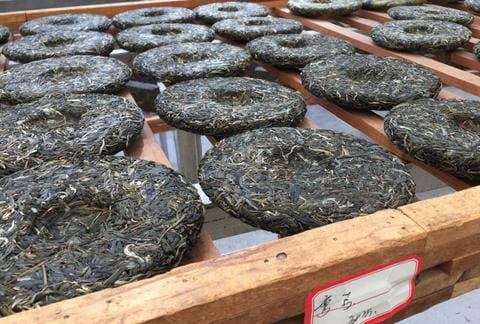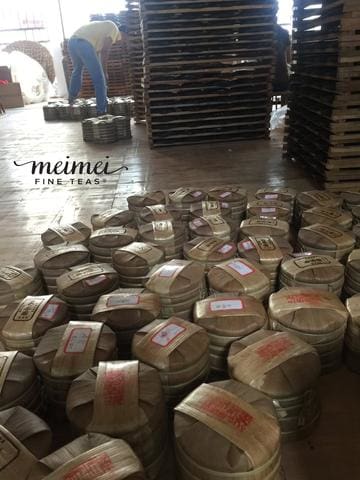
Pu-erh is a unique form of tea that defies inclusion in the common categories of white, green, oolong, and black. Depending on its age, you might find it more similar to a green tea or a black tea in terms of its flavor and appearance, and yet, at the same time, you’ll notice that it manages to exceed both in complexity—the leaves tend to be larger, the flavors more pronounced, the colors deeper.
Other than the fact that pu-erh can be aged, another feature that accounts for the wide difference in aromatics and flavor profiles is the fact that there are two different types of pu-erh, sheng and shu. Do you know the difference between the two? Have you ever wondered which might be right for you?
Let’s take a look at this traditional distinction and see if we can shed some light on it.
Pu-erh is initially crafted using techniques similar to those employed in making green tea. Whereas in green tea, younger leaves tend to be more highly prized and plucked for processing, it is the older, larger leaves that are valued in crafting pu-erh. Once plucked and ready, these leaves are fired in a wok and then sun-dried.

At this stage, the pu-erh can be pressed into cakes to make sheng cha (“raw tea”). Even though the tea can be enjoyed immediately, sheng pu-erh is made with the assumption that it will be aged, its best flavors yet to come.
To help facilitate this, it is not uncommon for a tea master to initiate this process, keeping these tea cakes under strict storage conditions for a few months before presenting them to the market. These storage areas usually feature a well-ventilated space that maintains a temperature of approximately 60-85°F (15-30°C) and a humidity range of 55–80%, creating conditions that allow fermentation to take place (a natural metamorphosis of the tea that encourages the formation of wildly complex flavors).
Once in your possession, you may elect to drink your pu-erh now or continue aging it on your own. In terms of optimizing the flavor, at a minimum, such pu-erh ought to be reserved for six months from the date of production before it is infused, but storing it for longer periods of time is wholly dependent on the quality of the pu-erh. Inferior teas will see little benefit beyond a few years of storage while higher quality leaves will continue to mature and develop as long as 5, 10, even 40 years out!

Besides sheng pu-erh, there is also shu cha (“ripe or cooked tea”), Whereas the aging process that brings out the unique flavors of sheng pu-erh take some time, tea masters at the Kunming Tea Factory in 1973 discovered that this tea could be artificially aged, accelerating the maturation of the leaves by manipulating the environmental storage conditions.
Using some basic chemistry and piling a large volume of the damp pu-erh leaves together in a patented step known as wuodui, the leaves are then subjected to controlled air and forced heat. If the tea masters miscalculate anything during this process, the tea leaves can easily be burnt or ruined, and so they require frequent attention, needing carefully re-piled at least four to six times throughout a 45 to 60 day period. Once the leaves satisfactorily survive, they are then pressed into cakes and taken to the market as shu pu-erh.
Even though shu pu-erh is made through a process that simulates long-term aging, the taste of an artificially aged pu-erh is still very different from the taste of a naturally aged one. In neither case should a pu-erh ever taste moldy, but in general, sheng pu-erhs tend to develop more of a spring honey and wildflower flavor whereas shu pu-erhs will taste more similar to baked fruit and herbs. Of course, these are just general guidelines; each pu-erh is a world unto its own and many will surprise.
When you are ready to purchase pu-erh for yourself, be sure to take a look at our Three Things You Should Know about Pu-Erh Guide, which gives you an idea of how to evaluate the quality of a pu-erh when you are shopping online or elsewhere.
Moreover, if you happen to reside in the Washington, DC or northeast Virginia area, you may want to strongly consider signing up for our Pu-Erh Tea Fundamentals and Tasting Flight class, conducted by Victoria Wu, founder and curator of MeiMei Fine Teas.
Victoria travels to China at least twice each year to sample and source rare, high-quality teas. During this class, you’ll learn about the history of pu-erh, understand the importance of terroir, and experience the difference between sheng and shu pu-erhs. It is the perfect tasting flight for beginners and connoisseurs alike.







Leave a comment